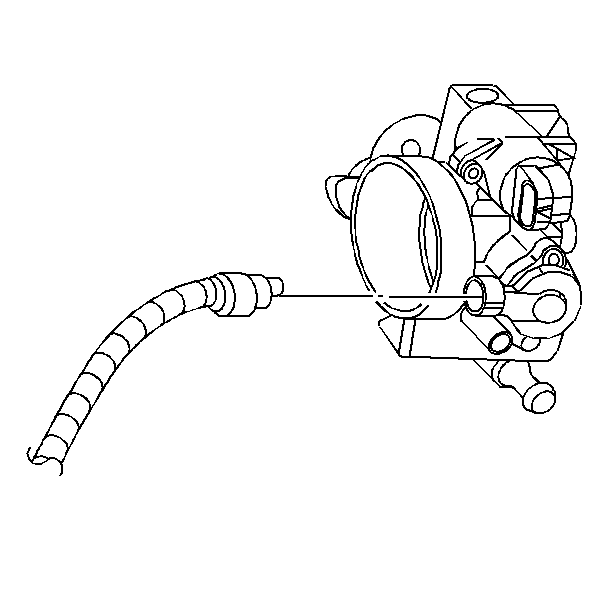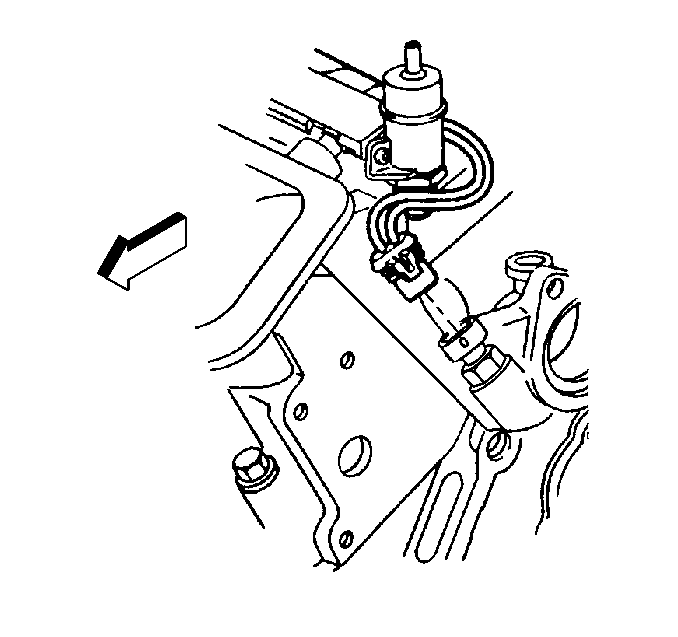Intake Manifold Replacement Upper
Removal Procedure
- Disconnect the negative battery cable.
- Remove the air cleaner assembly cover. Refer to Air Cleaner Assembly Replacement
- Drain and recover the cooling system. and to Cooling System Draining and Filling in Engine Cooling.
- Remove the exhaust gas recirculation (EGR) valve, if equipped. Refer to Exhaust Gas Recirculation Valve Replacement in Engine Controls - 3.4L.
- Remove the brake vacuum pipe at the plenum.
- Disconnect the fuel pressure regulator vacuum hose (1) from the fuel pressure regulator (3) and the PCV valve (2).
- Remove the secondary ignition wires from the spark plugs. Refer to Spark Plug Wire Harness Replacement in Wiring Systems.
- Remove the secondary ignition wires from the harness at the plenum. Refer to Spark Plug Wire Harness Replacement in Wiring Systems.
- At the same time, remove the electronic ignition coil and module assembly, and the evaporative emissions (EVAP) canister purge solenoid.
- Disconnect the throttle position (TP) sensor.
- Disconnect the idle air control (IAC) sensor.
- Disconnect the Injector harness.
- Disconnect the engine coolant temperature (ECT) sensor.
- Disconnect the camshaft position (CMP) sensor.
- Disconnect the vacuum modulator.
- Remove the manifold absolute pressure (MAP) sensor vacuum line (3).
- Disconnect the electrical connector.
- Remove the bolts (2).
- Remove the MAP sensor (1).
- Disconnect the coolant hoses from the throttle body.
- Remove the upper intake manifold bolts.
- Remove the upper intake manifold and gaskets.
- Clean the gasket surfaces.
Caution: Unless directed otherwise, the ignition and start switch must be in the OFF or LOCK position, and all electrical loads must be OFF before servicing any electrical component. Disconnect the negative battery cable to prevent an electrical spark should a tool or equipment come in contact with an exposed electrical terminal. Failure to follow these precautions may result in personal injury and/or damage to the vehicle or its components.









Installation Procedure
- Install the upper intake manifold gaskets on the manifold.
- Apply thread lock GM PN 12345382 to the threads of the bolts.
- Install the bolts (2).
- Install the MAP sensor vacuum line (3).
- Connect the MAP sensor electrical connector.
- Connect the vacuum modulator.
- Install the vacuum hose (1) to the fuel pressure regulator (3) and the crankcase ventilation valve (2).
- Connect the throttle position (TP) sensor.
- Connect the IAC.
- Connect the injector harness.
- Connect the engine coolant temperature (ECT) sensor.
- Connect the camshaft position (CMP) sensor.
- Connect the coolant hoses from the throttle body.
- Install the EVAP canister purge solenoid.
- Install the electronic ignition coil and module assembly.
- Install the secondary ignition wires to the spark plugs.
- Install the secondary ignition wires to the harness at the plenum.
- Install the EGR valve, if equipped. Refer to Exhaust Gas Recirculation Valve Replacement in Engine Controls - 3.4L.
- Install the throttle body cable to the throttle body.
- Install the cruise control cable to the throttle body.
- Install the top half of the air cleaner assembly.
- Install the brake vacuum pipe.
- Fill the cooling system. Refer to Cooling System Draining and Filling in Engine Cooling.
- Connect the negative battery cable.
- Inspect for proper fluid levels.
- Inspect for leaks.

Notice: Use the correct fastener in the correct location. Replacement fasteners must be the correct part number for that application. Fasteners requiring replacement or fasteners requiring the use of thread locking compound or sealant are identified in the service procedure. Do not use paints, lubricants, or corrosion inhibitors on fasteners or fastener joint surfaces unless specified. These coatings affect fastener torque and joint clamping force and may damage the fastener. Use the correct tightening sequence and specifications when installing fasteners in order to avoid damage to parts and systems.
Install the upper intake manifold bolts.
Tighten
Tighten the bolts to 25 N·m (18 lb ft).










Intake Manifold Replacement Lower
Removal Procedure
Tools Required
J 23600-B Torque Angle Meter
- Remove the upper intake manifold. Refer to Intake Manifold Replacement.
- Remove the fuel lines at the fuel rail and the bracket.
- Remove the fuel rail with injectors. Refer to Fuel Injection Fuel Rail Assembly Replacement in Engine Controls - 3.4L.
- Remove the power steering mounting bolts. Support the pump aside. Refer to Power Steering Pump Replacement in Power Steering Systems.
- Remove the inlet cooling pipe from the coolant outlet housing. Refer to Engine Coolant Inlet Pipe Replacement in Engine Cooling.
- Remove the heater by-pass at the coolant pump and the cylinder head.
- Remove the radiator hose at the heater outlet housing.
- Remove the water outlet housing. Refer to Water Outlet Housing Replacement in Engine Cooling.
- Remove both of the valve rocker covers. Refer to Valve Rocker Arm Cover Replacement.
- Remove the lower intake manifold bolts and DISCARD the bolts.
- Remove the lower intake manifold.
- Remove the pushrods. Refer to Valve Rocker Arm and Push Rod Replacement.
- Remove the intake gasket.




Important: Retain the washers in the same orientation on the center bolts.

Installation Procedure
- Install the intake manifold gasket.
- Install the pushrods. Refer to Valve Rocker Arm and Push Rod Replacement.
- With gaskets in place apply a small drop 8-10 mm (0.31-0.39 in) of RTV sealer GM P/N 12346141 (Canadian P/N 89022195) or equivalent to the 4 corners of the intake manifold to block joint (1).
- Connect the 2 small drops with a bead of RTV sealer that is between 8-10 mm (0.31-0.39 in) wide and 3.0-5.0 mm (0.12-0.20 in) thick (2).
- Install the lower intake manifold.
- Install NEW lower intake manifold bolts.
- Tighten the lower intake manifold bolts in sequence to 7 N·m (62 lb in) on the first pass.
- Tighten the lower intake manifold bolts (1, 2, 3, 4) in sequence to 13 N·m (115 lb in) on the final pass.
- Tighten the lower intake manifold bolts (5, 6, 7, 8) in sequence to 25 N·m (18 lb ft) on the final pass.
- Install the water outlet housing. Refer to Water Outlet Housing Replacement in Engine Cooling.
- Install the radiator hose to the thermostat housing.
- Install the heater inlet pipe to the thermostat housing.
- Install the fuel injector rail assembly.
- Install the fuel injector rail bolts.
- Install the fuel feed and return pipe retaining clip.
- Install the fuel feed and return pipe retaining clip bolt.
- Install the upper intake manifold. Refer to Intake Manifold Replacement.
- Install the valve rocker covers. Refer to Valve Rocker Arm Cover Replacement.
Important: All gasket-mating surfaces need to be free of oil, and foreign material. Use GM P/N 12346139 (Canadian P/N 10953463) or equivalent to clean surfaces.


Important: All gasket-mating surfaces need to be free of oil, and foreign material. Use GM P/N 12346139 (Canadian P/N 10953463) or equivalent to clean surfaces.
Notice: Refer to Fastener Notice in the Preface section.

Important: All lower intake manifold bolts need to be cleaned and free of any foreign material, only new bolts are to be used.
Important: Manufacturer recommends the center bolts be fully torqued before the diagonal bolts to assure proper seal ability.
Important: Lower intake manifold bolts in location 6 and 7 should be torqued to specification using a crows foot type tool.
Tighten


Important: Do not press on the fuel pressure regulator valve when installing the fuel injector rail assembly.
| 10.1. | Install the fuel injector O-rings using GM P/N 12345616, (Canadian P/N 993182) or equivalent. |
| 10.2. | Install the injector nozzles into the lower intake manifold injector bores. |
| 10.3. | Press on the injector rail using the palms of both hands until the injectors are fully seated. |
Tighten
Tighten the fuel injector rail bolts to 10 N·m (89 lb in).

Tighten
Tighten the fuel feed and return pipe retaining clip bolt to 8 N·m (71 lb in).

